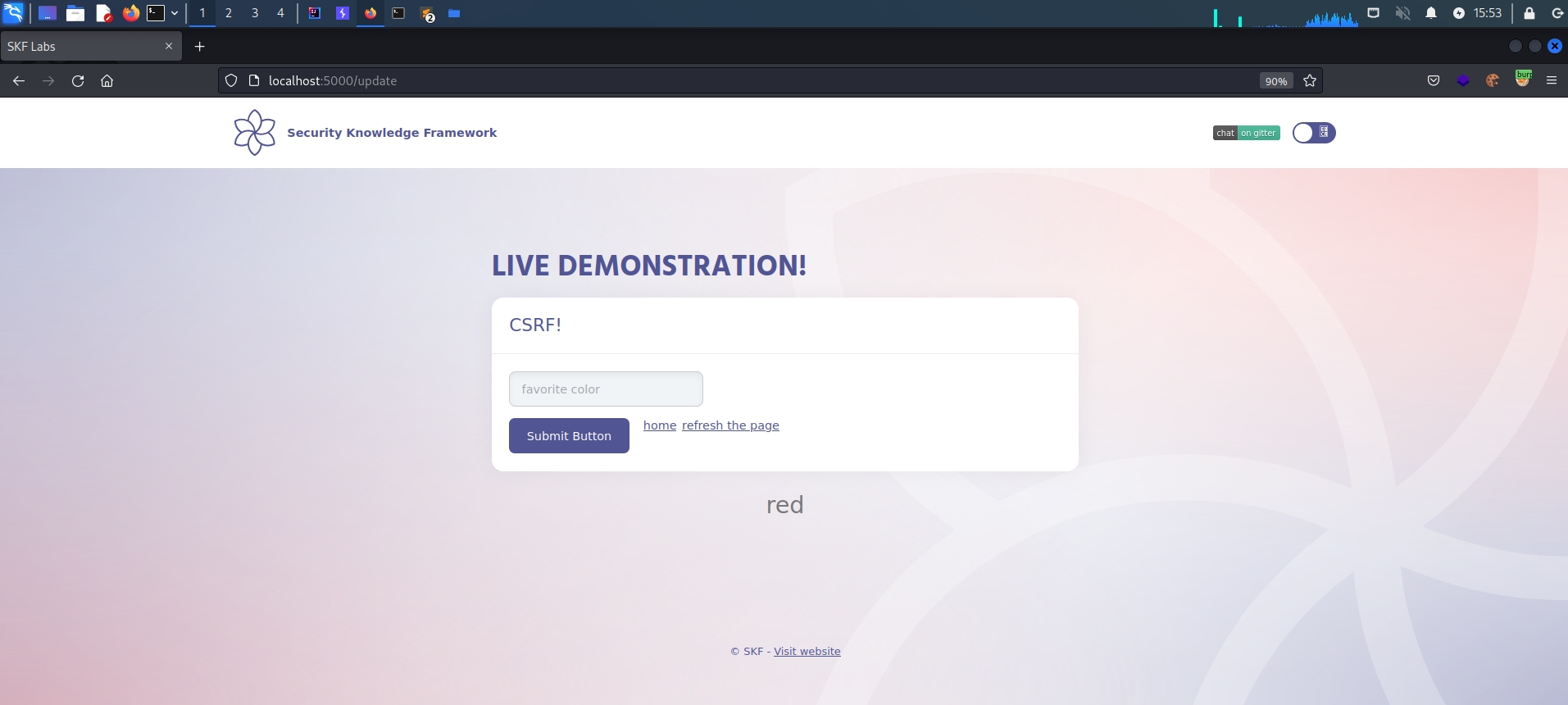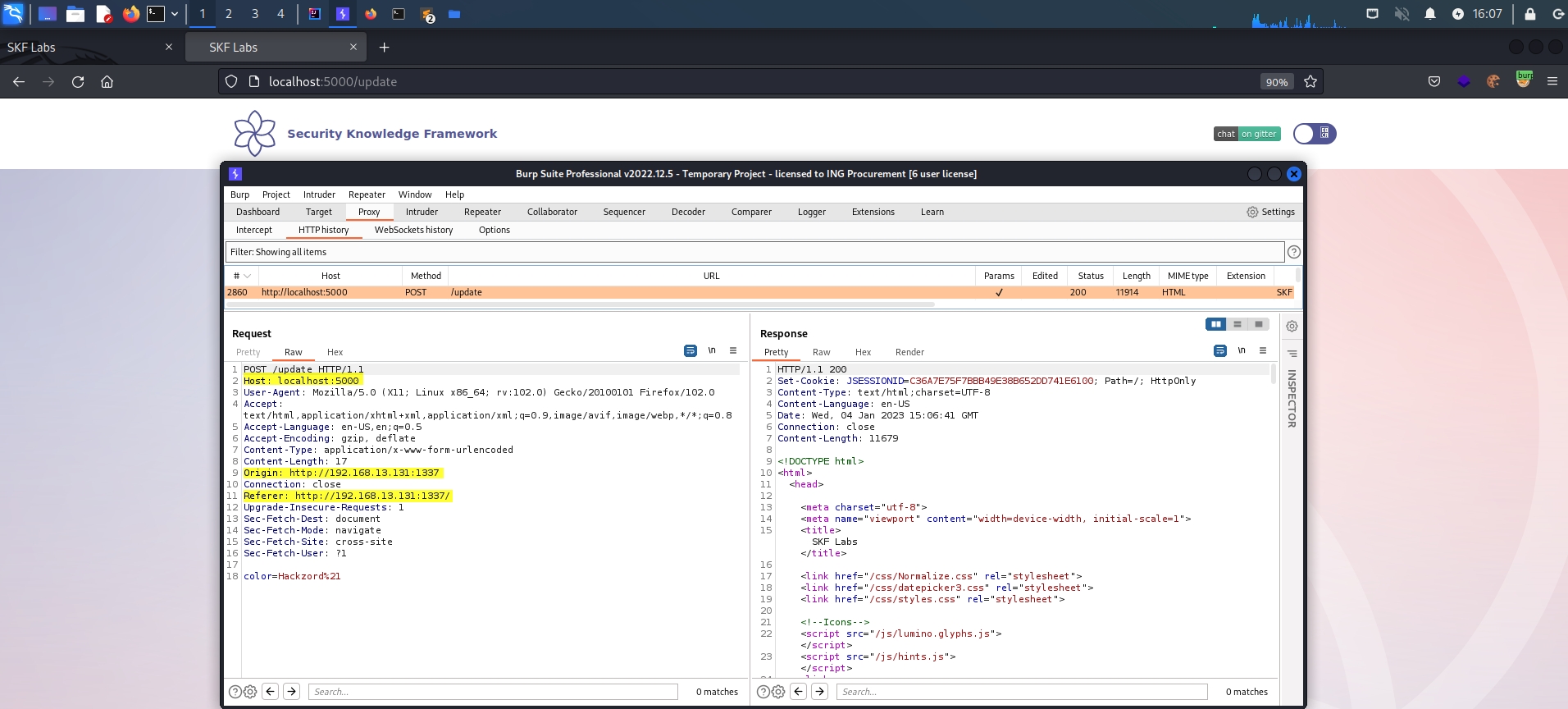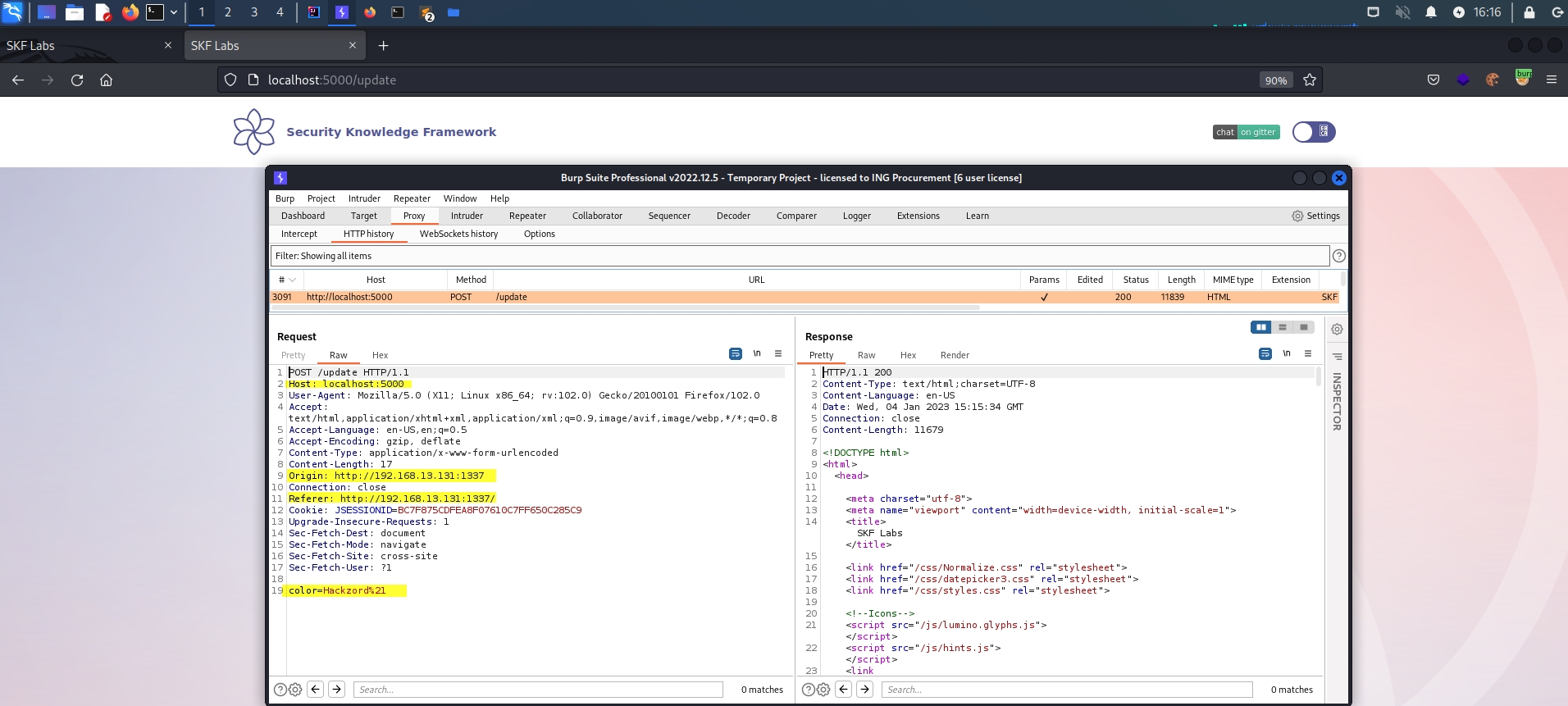Java - CSRF-SameSite
Running the app on Docker
$ sudo docker pull blabla1337/owasp-skf-lab:java-csrf-samesite$ sudo docker run -ti -p 127.0.0.1:5000:5000 blabla1337/owasp-skf-lab:java-csrf-samesiteNow that the app is running let's go hacking!
Reconnaissance
CSRF is an attack that tricks the victim into submitting a malicious request. It inherits the identity and privileges of the victim to perform an undesired function on the victim's behalf. For most sites, browser requests automatically include any credentials associated with the site, such as the user's session cookie, IP address, Windows domain credentials, and so forth. Therefore, if the user is currently authenticated to the site, the site will have no way to distinguish between the forged request sent by the victim and a legitimate request sent by the victim.
CSRF attacks target functionality that causes a state change / data mutation on the server, such as changing the victim's email address or password, or purchasing something. Forcing the victim to retrieve data doesn't benefit an attacker because the attacker doesn't receive the response, the victim does. As such, CSRF attacks target state-changing requests.
It's sometimes possible to store the CSRF attack on the vulnerable site itself. Such vulnerabilities are called "stored CSRF flaws". This can be accomplished by simply storing an IMG or IFRAME tag in a field that accepts HTML, or by a more complex cross-site scripting attack. If the attack can store a CSRF attack in the site, the severity of the attack is amplified. In particular, the likelihood is increased because the victim is more likely to view the page containing the attack than some random page on the Internet. The likelihood is also increased because the victim is sure to be authenticated to the site already.
Lets start the application and login with the default credentials.
username : admin
password: admin
When we are loggedin to the application we can see that we can set our favorite color and this will be stored in the session of the user.

If we inspect the request with an intercepting proxy we can see that the application is performing a POST request that results in a data mutation, storing our favorite color into the session of the user and displaying this back to the user in the HTML website.

Also we can see that the application is not using any form of protection for preventing CSRF because there is no unique token being send in the POST request.
Exploitation
In order to to exploit this vulnerability we need to set up our evil webserver to do the malicious CSRF using a POST request from. We could achieve this by creating the following python flask application.
Save the snippet above to > app.py and run the commands below to install some dependencies.
Of course you can also run your app on whatever service you want it does not have to be python flask.
Now that the service is running we want to serve the malicious piece of javascript that is responsible for performing the malicious CSRF POST request.
Save the snippet above to > templates/evil.html and run the command below to start our evil application.
Now when we have in the browser tab our active session of the application we can open a new tab where we will load our evil page we just created.
This will now create a POST request to the application and changing the value of blue to the new value of 'Hackzord!' As you can see the Referer is set to our evil website where the request originated from.

Also when we refresh the original page of the application we can see that the new value has been replaced with the content of our evil app.

SameSite Attribute
The modern browsers have introduced a defense in depth mechanism against CSRF type of attacks, the SameSite cookie attribute.
This attribute allows the user-agents to identify whether a cookie should be sent along with cross-site-requests or not.
It can be set with the following values:
Strict
Cookie will be only sent with same-site requests.
Lax
Cookie will be sent with same-site requests and, also, with cross-site-requests generated after top-level navigation (by clicking on a link) that are not CSRF-prone.
None
Cookies will always be sent with cross-site-requests.
To make this concept more clear, let's exercise it within this SKF Lab.
In the home page, use the Secure Login form for authentication.

You can note in Burp's response tab the cookie was set with samesite=strict.
Set your preferred color.
Now, in a different browser tab, try to run again the CSRF attack.

Go back to the first tab and check if the color was changed by the CSRF attack or not by clicking on refresh the page.

Nothing has changed!
Looking at request logged in Burp, we can understand the reason.

As the cookie was set in Strict mode, the browser was instructed to not send it with any cross-site-request. Thus, as Color Change requires an authenticated session, this request is treated as anonymous one and, therefore,rejected by the application.
Let's see how Lax mode works, by using the Login Still Insecure authentication form.

You can note in Burp's response tab the cookie was set with samesite=lax.
Set your preferred color and once again run the CSRF attack in a different tab.
Go back to the first tab and check if the color has changed by the CSRF attack or not, by clicking on refresh the page.
Nothing has changed again! Lax mode also blocked the cookie to be sent over POST cross-site-request.

This lab was specially designed to also accept GET query string parameters for color changing.
Now adapt the CSRF Evil Server page to send a GET request as link and click on it.

The request will be executed containing the required cookies, therefore, the CSRF attack is successful.


Lax mode allowed the browser to send the cookie through the cross-site-request after top-level navigation using a non-CSFR method (GET). In other words, if the application accepts GET query string parameters to change data in persistence(or allows POST requests being converted into GET), CSRF attack will also succeed.
Additional sources
Last updated
Was this helpful?